ZTE GS516 GSM Wireless Phone User Manual Q78 GS516
ZTE Corporation GSM Wireless Phone Q78 GS516
ZTE >
Contents
- 1. User manual
- 2. User Manual
User manual
ZTE-G S516
Mobile Phone
User Manual
LEGAL INFORMATION
Copyright © 2011 ZTE CORPORATION.
All rights reserved.
No part of this publication may be excerpted, reproduced, translated or utilized in
any form or by any means, electronic or mechanical, including photocopying and
microfilm, without the prior written permission of ZTE Corporation.
The manual is published by ZTE Corporation. We reserve the right to make
modifications on print errors or update specifications without prior notice.
Version No. :
Edition Time :
Manual No. :

3
Table of Contents
SECURITY ........................................ 4
SAFETY PRECAUTIONS ................. 4
FCC COMPLIANCE ........................ 10
LIMITATION OF LIABILITY ............ 13
KEY FUNCTIONS ........................... 14
LOCKING AND UNLOCKING THE
KEYPAD .......................................... 16
INTERFACE ICONS ....................... 16
BATTERY ........................................ 17
INSERTING THE SIM CARD .......... 19
INSERTING THE MEMORY CARD 20
CHARGING THE BATTERY ........... 20
POWERING YOUR PHONE ON/OFF
........................................................ 22
TURNING THE TORCH ON/OFF ... 22
WRITING TEXT .............................. 22
HOW TO ADD PEOPLE TO THE
PHONEBOOK ................................. 23
HOW TO MAKE AND RECEIVE
CALLS ............................................ 24
HOW TO SEND MESSAGES ......... 24
HOW TO RECEIVE A MESSAGE .. 25
HOW TO SET PROFILES .............. 25
HOW TO VIEW CALL HISTORY .... 26
HOW TO CONFIGURE CALL
SETTINGS ...................................... 26
HOW TO SET YOUR PHONE ........ 26
RADIO ............................................ 27
EXTRAS ......................................... 28
ALARM ........................................... 29
MOVISTAR ..................................... 29

4
Security
To protect your mobile phone from illegal use, take the security measures as
follows:
¾ Set PIN codes of the SIM card.
¾ Set handset password.
¾ Set call restrictions.
Safety Precautions
This section includes some important information on safe and efficient operation.
Please read this information before using the phone.
Operational Precautions
Please use your phone properly. When making or receiving a call, please hold your
phone as holding a wireline telephone. Make sure that the phone is at least one inch
(about two point five centimeters) from your body when transmitting.
Do not touch the antenna when the phone is in use. Touching the antenna area
affects call quality and may cause the phone to operate at a higher power level
than needed.
Some people may be susceptible to epileptic seizures or blackouts when exposed
to flashing lights, such as when watching television or playing video games. If
you have experienced seizures or blackouts, or if you have a family history

5
of such occurrences, please consult your doctor before playing video games on
your phone or enabling a flashing-light feature on your phone. (The flashing-light
feature is not available on all products.)
Keep the phone out of the reach of small children. The phone may cause injury
if used as a toy.
Precautions While Driving
Please pay attention to the traffic safety. Check the laws and regulations on
the use of your phone in the area where you drive. Always obey them.
Use hands-free function of the phone, if available.
Pull off the road and park before making or answering a call if conditions require.
Precautions for Medical Devices and Facilities
When using your phone near pacemakers, please always keep the phone more
than eight inches (about twenty centimeters) from the pacemaker when the
phone is switched on. Do not carry the phone in the breast pocket. Use the ear
opposite the pacemaker to minimize the potential for interference. Switch
off the phone immediately if necessary.
Some phones may interfere with some hearing aids. In the event of such interference,
you may consult your hearing aids manufacturer to discuss alternatives.
If you use any other personal medical device, please consult the manufacturer
of your device to determine if it is adequately shielded from RF (radio

6
frequency) energy.
In those facilities with special demand, such as hospital or health care facilities,
please pay attention to the restriction on the use of mobile phone. Switch off
your phone if required.
Mobile Phone
Please use original accessories or accessories approved by the phone
manufacturer. Using any unauthorized accessories may affect your mobile
phone’s performance, damage your phone or even cause danger to your body
and violate related local regulations about telecom terminals.
Turn off your phone before you clean it. Use a damp or anti-static cloth to
clean the phone. Do not use a dry cloth or electrostatically charged cloth. Do
not use chemical or abrasive cleaners as these could damage the phone.
As your mobile phone can produce electromagnetic field, do not place it near
magnetic items such as computer disks.
Using the phone near electrical appliances such as TV, telephone, radio and
personal computer can cause interference.
Do not expose your mobile phone to direct sunlight or store it in hot areas. High
temperatures can shorten the life of electronic devices.
Keep your phone dry. Any liquid may damage your phone.
Do not drop, knock or harshly treat the phone. Rough handling can break
internal circuit boards.

7
Do not connect the phone with any incompatible enhancement.
Do not attempt to disassemble the mobile phone or battery.
Do not store the phone with flammable or explosive articles.
Do not charge the mobile phone without battery.
Some electronic devices are susceptible to electromagnetic interference sent by
phone if inadequately shielded. Please use phone at least 20 cm or as far
away as you can from TV set, radio and other automated office equipment so
as to avoid electromagnetic interference.
Precautions for Potentially Explosive Atmospheres
Switch off your phone prior to entering any area with potentially explosive
atmospheres, such as fueling areas, fuel or chemical transfer or storage facilities.
Do not remove, install, or charge batteries in such areas. Spark in a potentially
explosive atmosphere can cause an explosion or fire resulting in bodily injury
or even death.
To avoid possible interference with blasting operations, switch off your phone
when you are near electrical blasting caps, in a blasting area, or in areas
posted “Turn off electronic devices.” Obey all signs and instructions.
Precautions for Electronic Devices
Some electronic devices are susceptible to electromagnetic interference sent

8
by mobile phone if inadequately shielded, such as electronic system of vehicles.
Please consult the manufacturer of the device before using the phone if necessary.
Safety and General Use in Vehicles
Safety airbag, brake, speed control system and oil eject system shouldn’t be affected
by wireless transmission. If you do meet problems above, please contact your
automobile provider. Do not place your phone in the area over an airbag or in the
airbag deployment area. Airbags inflate with great force. If a phone is placed in the
airbag deployment area and the airbag inflates, the phone may be propelled with great
force and cause serious injury to occupants of the vehicle.
Please turn off your mobile phone at a refueling point, and the same to the
place where the use of two-way radio is prohibited.
Aircraft Safety
Please turn off your mobile phone before the airplane takes off. In order to
protect airplane’s communication system from interference, it is forbidden to
use mobile phone in flight. Safety regulations require you to have permission
from a crew member to use your phone while the plane is on the ground.
If the mobile phone has the function of automatic timing power-on, please check your
alarm setting to make sure that your phone will not be automatically turned on during
flight.

9
Battery Use
Do not short-circuit the battery, as this can cause the unit to overheat or ignite.
Do not store battery in hot areas or throw it into fire. Otherwise, it will cause
explosion.
Do not disassemble or refit the battery. Otherwise, it will cause liquid leakage,
overheating, explosion and ignition of the battery.
Please store the battery in a cool dry place if you don’t use it for a long period.
The battery can be recharged for hundreds of times, but it will eventually wear
out. When the operating time (talk time and standby time) is noticeably shorter
than normal, it is time to replace it with a new one.
Please stop using the charger and battery when they are damaged or show
evidence of aging.
Return the worn-out battery to the provider or dispose of it in accordance with
environment regulations. Do not dispose of it in household rubbish.
Please use original batteries or batteries approved by the phone manufacturer.
Using any unauthorized battery may affect your handset performance or may
cause danger of explosion, etc.
Warning: If the battery is damaged, do not discharge it. If the leakage does come
into contact with the eyes or skin, wash thoroughly in clean water and consult a
doctor.

10
FCC Compliance
This device complies with part 15 of the FCC Rules. Operation is subject to the
following two conditions: (1) This device may not cause harmful interference,
and (2) this device must accept any interference received, including interference
that may cause undesired operation.
Caution: Changes or modifications not expressly approved by the
manufacturer could void the user’s authority to operate the equipment.
NOTE: This equipment has been tested and found to comply with the limits for a
Class B digital device, pursuant to part 15 of the FCC Rules. These limits are
designed to provide reasonable protection against harmful interference in a
residential installation. This equipment generates, uses and can radiate radio
frequency energy and, if not installed and used in accordance with the
instructions, may cause harmful interference to radio communications. However,
there is no guarantee that interference will not occur in a particular installation.
If this equipment does cause harmful interference to radio or television
reception, which can be determined by turning the equipment off and on, the
user is encouraged to try to correct the interference by one or more of the
following measures:
—Reorient or relocate the receiving antenna.
—Increase the separation between the equipment and receiver.
—Connect the equipment into an outlet on a circuit different from that to which
the receiver is connected.
—Consult the dealer or an experienced radio/ TV technician for help.

11
Health and safety information
Radio Frequency (RF) Energy
This model phone meets the government’s requirements for exposure to radio
waves.
This phone is designed and manufactured not to exceed the emission limits for
exposure to radio frequency (RF) energy set by the Federal Communications
Commission of the U.S. Government:
The exposure standard for wireless mobile phones employs a unit of
measurement known as the Specific Absorption Rate, or SAR. The SAR limit
set by the FCC is 1.6W/kg. *Tests for SAR are conducted using standard
operating positions accepted by the FCC with the phone transmitting at its
highest certified power level in all tested frequency bands. Although the SAR
is determined at the highest certified power level, the actual SAR level of the
phone while operating can be well below the maximum value. This is because
the phone is designed to operate at multiple power levels so as to use only the
poser required to reach the network. In general, the closer you are to a
wireless base station antenna, the lower the power output.
The highest SAR value for the model phone as reported to the FCC when tested
for use at the ear is 0.426 W/kg and when worn on the body, as described in
this user guide, is 0.271 W/kg (Body-worn measurements differ among phone
models, depending upon available enhancements and FCC requirements.)
While there may be differences between the SAR levels of various phones and at

12
various positions, they all meet the government requirement.
The FCC has granted an Equipment Authorization for this model phone with all
reported SAR levels evaluated as in compliance with the FCC RF exposure
guidelines. SAR information on this model phone is on file with the FCC and
can be found under the Display Grant section of http://www.fcc.gov/oet/fccid
after searching on
FCC ID: Q78-GS516
For body worn operation, this phone has been tested and meets the FCC RF
exposure guidelines for use with an accessory that contains no metal and the
positions the handset a minimum of 1.5 cm from the body. Use of other
enhancements may not ensure compliance with FCC RF exposure guidelines.
If you do not use a body-worn accessory and are not holding the phone at the
ear, position the handset a minimum of 1.5 cm from your body when the phone
is switched on.

13
Limitation of Liability
ZTE shall not be liable for any loss of profits or indirect, special, incidental or
consequential damages resulting from or arising out of or in connection with
using this product, whether or not ZTE had been advised, knew or should have
known the possibility of such damages. The user should refer to the enclosed
warranty card for full warranty and service information.
Note: The pictures and icons shown in the manual are just schematic drawings
for function demonstration. If they are inconsistent with your handset, please take
your handset as the standard. If the inconsistency exits in the manual because of
the handset function updating, please refer to the follow-up public information
from ZTE CORPORATION.
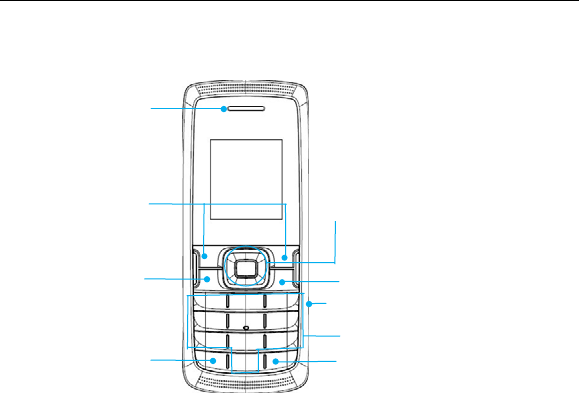
14
Key Functions
Earpiece
Left/Right soft key 4-Way Navigation
keys and Center key
Send key End/Power key
A
lpha numeric keys
Charger /headset interface
* key # key
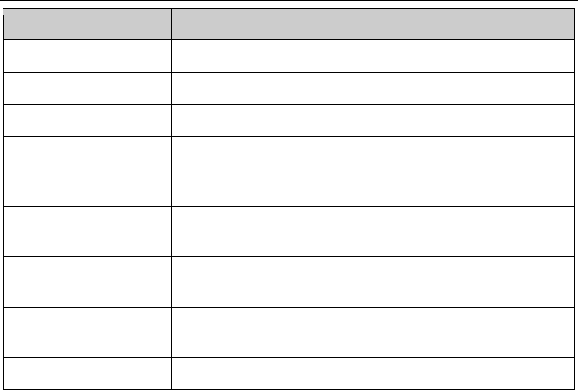
15
Function Description
Left soft key Performs the function indicated at the left bottom of the screen.
Right soft key Performs the function indicated at the right bottom of the screen.
Center key Press to confirm actions and make selections.
4-Way
Navigation keys
These keys (UP, DOWN, LEFT and RIGHT) allow for navigation
through menu options and quick accessing to some function
menus.
Send key Press to dial a phone number or answer a call, or view the call
history in the standby mode.
End/Power key Press to exit to the standby mode.
Hold to switch on/off the phone.
* key and # key They have different functions in different modes or function
menus.
Alpha numeric keys Press to enter digits 0-9 and the alphabets from a-z or A-Z.
Note: In this User Manual, “press a key” means to press the key and release it
immediately, while “hold a key” means to press the key for at least two seconds and
then release it.
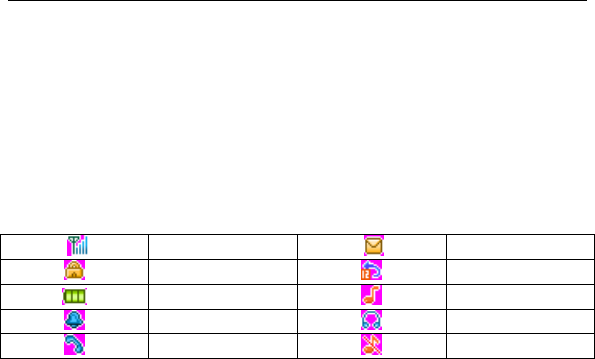
16
In the standby mode, press Center key to enter the main menu interface.
Locking and Unlocking the Keypad
In the standby mode, press the Center key and then press the * key within two
seconds to lock the keypad.
Press Left soft key and then press the * key within two seconds to unlock the
keypad.
Locking the keypad can prevent unintentional operations on it. You can answer
an incoming call with the regular operation when the keypad is locked.
Interface Icons
Signal strength New SMS
Keypad locked Call diverting
Battery status General
Alarm clock set Headset
Missed call Silent
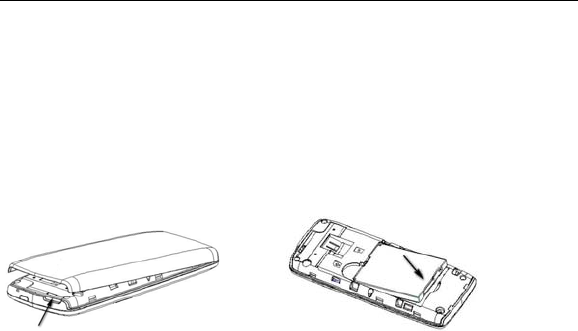
17
Battery
The lithium ion battery of the mobile phone can be immediately used after unpacking.
Installing the battery
1. Pull the battery cover from the notch on the top edge and remove the cover.
2. Insert the battery by aligning the gold-coloured contacts with the contacts in
the battery slot.
3. Push down the upper section of the battery until it clicks into place.
4. Fix the battery cover till you hear the click sound.
Remove the battery cover Push down the battery
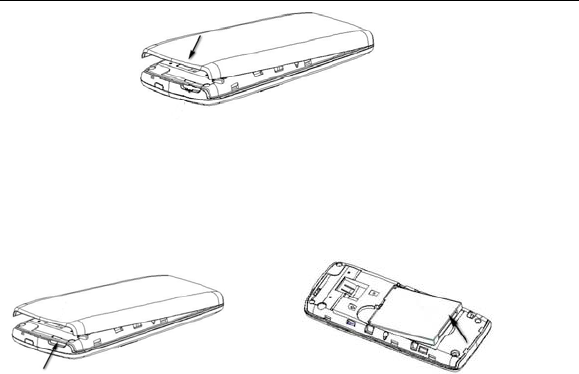
18
Fix the battery cover till you hear the click sound
Removing the battery
1. Make sure that your mobile phone is switched off.
2. Remove the battery cover.
3. Pull the battery up and remove it from the mobile phone.
Remove the battery cover Pull up the battery from here
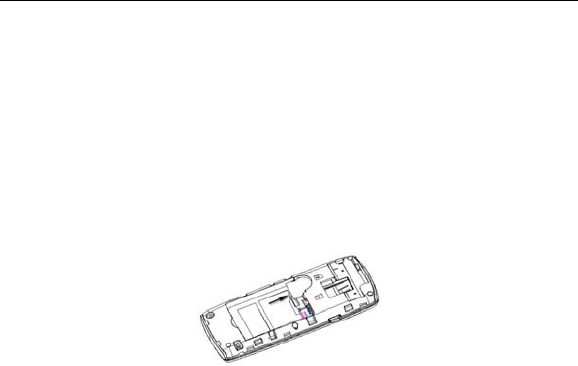
19
Inserting the SIM Card
Insert the SIM card as follows:
1. Make sure that the phone is switched off and the charger is disconnected
from the phone.
2. Turn the phone over and remove the battery cover.
3. Remove the battery if it is already installed.
4. Hold your SIM card with the cut corner oriented as shown and then slide it
into the card holder with the gold-coloured contacts facing downwards.
5. Install your battery.
6. Fix the battery cover till you hear the click sound.
Insert the SIM card
SIM (Subscriber Identity Module) card is a micro chip from a network provider
that keeps the carrier details and customers information such as names and
phone numbers. Your phone won’t work without it. If you already have contacts
on your SIM card, they can be transferred in most cases.
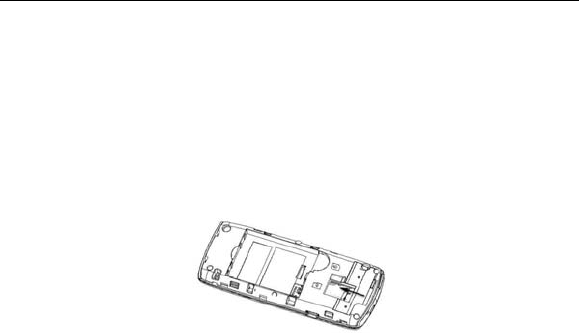
20
Inserting the Memory Card
You can use a memory card to expand the storage of the phone. You can
store or copy files such as music and so on.
Do not take out the card or switch off the phone while transmitting or storing data,
which may cause data loss or damage to the phone or the card.
Insert the memory card as follows:
The memory card slot is beside the SIM card holder. You can insert the memory
card as shown in the diagram below. Open the battery cover. Insert the card with
the metal contacts facing downwards until it clicks to the right position.
Insert the Memory card
Charging the Battery
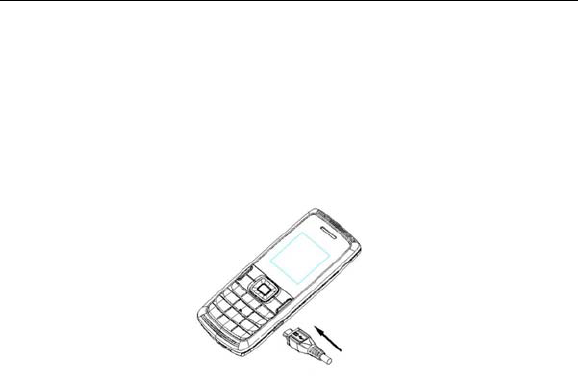
21
Your phone is powered by a rechargeable battery. For maximum battery performance,
it is recommended that you first use up the battery power and then charge it
completely. A new battery’s full performance is achieved only after three complete
charge and discharge cycles.
1. Connect your travel adapter to the right side of your mobile phone as
shown in the diagram.
2. Connect the other end of the travel adapter to the mains socket.
3. When you charge the battery, the battery charging indicator appears.
4. When the battery is fully charged, disconnect the charger.

22
Powering your Phone On/Off
Make sure that your SIM card is in your mobile phone and that the battery is
charged.
Hold the End/Power key to power on/off the phone. The phone will
automatically search for the network.
Turning the Torch On/Off
In the standby mode, hold the 0 key to turn on or off the torch. The torch is at
the bottom of the phone.
Writing Text
• Change input mode: Press the # key to change the input mode
(input modes: ABC, abc, ES, es, 123).
• Input letters: In ABC/abc/ES/es mode, constantly press the
corresponding letter key till the letter appears.
• Input digits: In 123 mode, press digit key once to input a digit. In
ABC/abc/ES/es mode, constantly press the digit key until the number appears.
• Input symbol: Press the * key to enter the symbol mode, select the
required symbol (common symbols) by pressing the Navigation keys and then
press the Left soft key or Center key to confirm it. In ABC/abc/ES/es mode,
constantly press the 1 key until the required symbol (common symbols)

23
appears.
• Input space: Press the 0 key to input space. It does not work in 123
mode.
• Delete character: Press the Right soft key to clear a character. Hold
the Right soft key to delete all characters and clear the display.
• Move cursor to left or right: Among the text, press the Left/Right
navigation keys to move the cursor to left or right.
How to Add People to the Phonebook
There are some numbers that you may want to call again and again, so it makes
sense to add these numbers to your Phonebook. You can then access these
numbers quickly and easily.
Go to Phonebook→Preferred storage to set the storage position.
• Go to Phonebook→Add new contact to add new contact.
• Edit the information and save it.
• You can also save a number right after you’ve made or received a
phone call or a message from someone who is not yet in your Phonebook list.
• To delete someone from your Phonebook list, go to
Phonebook→Contacts, first select the name, then select Options→Delete.

24
How to Make and Receive Calls
The most basic way to make a call is to input the number in the standby mode
and press the Send key. You can also make a call from the phonebook list.
• To call someone: Go to Phonebook→Contacts. Use the Up/Down
Navigation keys to find the name of the person you want to call. You can also
type in the first letter of the name of the person you want to call to find the right
name, and press the Send key.
• To receive a call, press the Left soft key or the Send key.
• To end a call, press the End/Power key.
• To reject a call, press the End/Power key.
Make sure that you are in an area with sufficient coverage to make calls. The
strength of the network signal is indicated on the Status Bar of the screen.
How to Send Messages
You can use your mobile phone to send and receive messages.
1. Go to Messages→Write message.
2. Write your message. For more information on input method, see section
‘Writing Text’. When you write an SMS, press Options→Send, and edit the
recipient.
3. When you finish writing an SMS, select Options to send the message.

25
How to Receive a Message
Upon receiving a message, the mobile phone will alert you with a ringtone, prompt,
or a new message icon. Inbox full when the message icon blinking.
1. Press View to open the new message. You can also go to Inbox to read the
message.
2. Use the Up/Down Navigation keys to view the message.
3. While the message is open, use Options to reply, delete, or forward the
message. You can go to Use number to save the sender’s number.
You can also receive broadcast messages by using this mobile phone.
Go to Messages→Voice mail, you can call the voicemail or edit the
voicemail.
How to Set Profiles
Go to Settings→Profiles. You can select Options→Activate to activate a
profile. Or you can select Options→Customize to edit a profile.
Note: The Silent mode can be only set Activate or not. And the Headset mode
can only be activated with the headset connected.

26
How to View Call history
Go to Call Registry.
Dialed calls, Received calls and Missed calls are saved in Call Registry. If the
records are full, the earliest saved records will be deleted automatically.
Also, you can view call timers, call cost in Call Registry.(Call cost need
network support.)
How to Configure Call Settings
Go to Settings→Call settings.
You can set call waiting, call divert and call barring and so on.
How to Set Your Phone
You can adjust various settings of your phone. Go to Settings.
• Phone settings: Set schedule power on/off, select language, set input
method, set greeting text and Auto keypad lock, etc.
• Network settings: Set to automatically or manually select network. Set

27
preferred networks.
• Security settings: Set security features to protect your phone and SIM
card from unauthorized use.
• Restore factory settings: Enter the phone password to restore to the
factory settings. Some personal information might be lost if you use this function,
so be careful.
Note: You may be required to input the phone password in some of the security
setting interfaces. The default phone password is 0000. Go to Security
settings→Phone security→Change password to change the phone password.
Radio
With the radio, you can search for radio channels, listen to them, and save
them on your device. Note that the quality of the radio broadcast depends on
the coverage of the radio station in that particular area. In the FM radio
interface, you can press Up/Down Navigation keys to adjust volume, press
Left/Right Navigation keys to tune the frequency, and press the Center key to
pause. Select Options to enter the submenu.

28
Extras
Go to Extras.
• Calendar
In calendar, you can view the current month and current date. Select Options to
view the submenu.
• Tasks
Select Add to add tasks.
• File manager
You can check all the folders in the phone or memory card, create new ones or
rename, delete, or sort, etc.
• Audio player
This function can be only used after you insert the memory card, otherwise this
function can’t be used.
• World clock
You can view the time in different cities.
• Calculator
You can perform simple calculations. Press digit key to enter the number. Press
Navigation keys to select the operational character. Select OK or press Center
key to get the result. Press Clear to delete the number.

29
Note: This calculator has limited accuracy and rounding errors may occur
especially in long division.
• Unit converter
You can convert the unit of weight and length in this menu.
• Currency converter
Your mobile phone provides you with basic functions of currency conversion.
Input the rate and local figure, then you can get the foreign figure.
• Stopwatch
Use it to record the time.
Alarm
You can view, and edit the alarm clock settings. You can also enable or disable
the alarms. By pressing Edit, you can set the corresponding features of the
alarm according to instructions.
movistar
Movistar allows you to use the STK.

30
• STK
SIM card Toolkit (STK) services are value-added services provided by your
network provider.
Your mobile phone supports STK service, but if your SIM card and network
provider do not support the service, these functions can’t be used.
*************